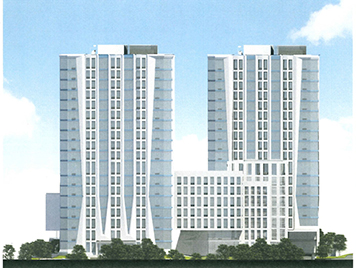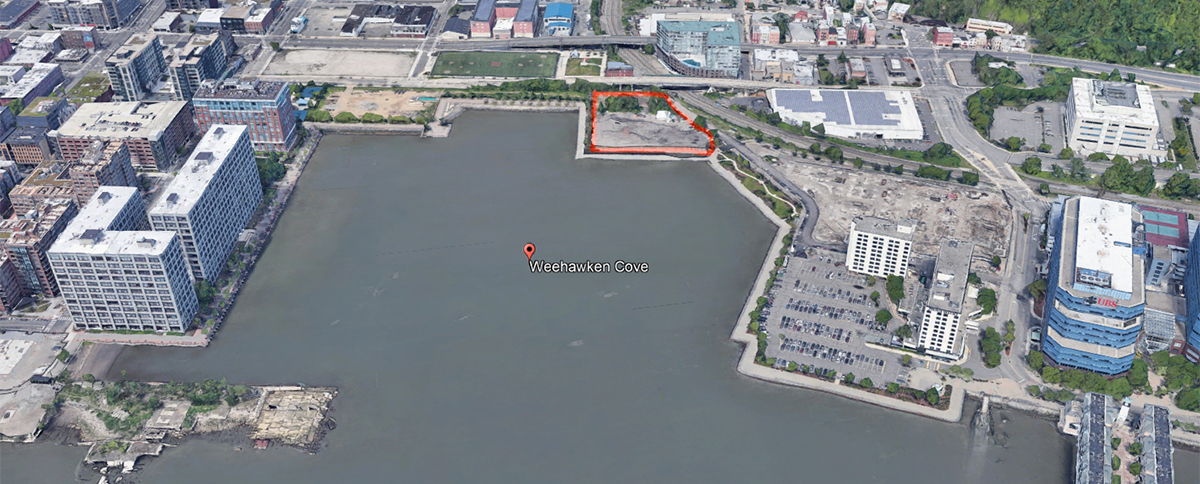In August, the Fund for a Better Waterfront and two other plaintiffs filed suit challenging the Weehawken Planning Board in their approval for two high-rise towers at the Weehawken Cove, on the Hoboken border. The basis for this legal action includes the following:
- The project fails to comply with ordinance standards for setbacks, coverage, distance between buildings, FAR (floor area ratio) and open space. For example, the development must provide a minimum of 20 percent open space but only allows for 9.8 percent. In addition, there is a 50 foot minimum front and rear yard setback requirement but the project proposes a mere 4.5 and 4 feet respectively.
- As a condition of its approval, Hartz is required to provide $220,000 to the Township of Weehawken to purchase two shuttle buses to allow Weehawken residents above the Palisades to access the waterfront. Such an obvious quid pro quo, unrelated to the impact of the project, is illegal.
- The failure to meet the FAR standard requires what is known as a “d” variance. Only the Zoning Board of Adjustment can grant such a variance, not the Planning Board.
- The Planning Board attorney, Elise Dinardo, also serves as an Assistant Municipal Attorney for the Township of Weehawken. Such an egregious conflict of interest is prohibited by New Jersey’s Municipal Land Use Law.
Last October, after six months of hearings, the Weehawken Planning Board rejected the initial application for this project, dubbed the Atir Site, that proposed 334 residential units in two 200-foot towers atop a seven story parking garage. This waterfront site is located at the south end of Hartz Mountain Industries’ 48-acre Lincoln Harbor project, just north of the Hoboken border. Objectors came from Weehawken, Union City and Hoboken to speak out at the hearings.
Subsequently, the Township of Weehawken amended its zoning ordinance, essentially to accommodate a scaled back project with 261 units and two 160-foot towers. After six hearings earlier this year, the Weehawken Planning Board this time granted approvals.
The Atir towers are planned to abut a four-acre public park that is being built by the Rebuild by Design project on the Hoboken side of the Weehawken Cove. Berms running the length of this park will conceal a flood wall that will protect against storm surges similar to what occurred during Superstorm Sandy in 2012. At the Weehawken border, the flood wall becomes a bleak, exposed structure, with the Atir project on the eastern side fronting the Hudson River. The Atir building would sit just 30 feet from the river, separated by the state-mandated waterfront walkway.
FBW and the other plaintiffs had filed another suit earlier this year challenging the amendments to the Weehawken zoning ordinance asserting that it constituted spot zoning and was based on an outdated Master Plan. Most likely, all these legal actions before the New Jersey Superior Court in Hudson County will be consolidated.
At one of the final hearings last May, Maryann Bucci-Carter, an urban planner, testified before the Weehawken Planning Board on behalf of the objectors. She explained that the latest thinking on urban redevelopment is “based on principles of how cities and towns developed in the last century, which is how Weehawken developed.” She explained that in the older Weehawken neighborhood atop the Palisades the layout of the streets is traditional. “They’re walkable blocks and streets. The housing and shopping is in close proximity. There’s accessible public spaces . . . the buildings are focused on human-scale planning and design.”
In her testimony, Ms. Bucci-Carter pinpointed the essential problem with the Atir project: its failure to create a real neighborhood. She also pointed to a planned development in Jersey City, Liberty Harbor North, that has been made successful by first laying out a traditional-style street grid. Facing the street are a mix of residential and retail uses. Walking down the blocks, one sees stoops, front doors and windows. Parking garages at the interior of the blocks are concealed behind the residential and retail uses.
A public street system is what is lacking at Weehawken’s Lincoln Harbor, which consists of just a few private roadways with no public parking. She also pointed out that the massive seven-story parking garage at the base of the Atir project results in a blank wall, devoid of life and activity at ground level and along the Waterfront Walkway.
The court will soon set up a schedule for briefs to be submitted by all parties and then set a date for the case to be argued before a judge. FBW is represent in this case by land-use attorney Gerald Muller of Miller, Porter & Muller in Princeton, New Jersey.
Related links
Latest Lincoln Harbor project disregards good planning principles
Liberty Harbor North Redevelopment Plan
Multiple lawsuits challenge new ordinance for Lincoln Harbor
Planning Board votes down high-rise towers at Weehawken Cove after persistent opposition
Objectors mobilize against massive towers proposed at Weehawken Cove
Col. Stevens vision for Hoboken still valid 200 years later
Hoboken’s first parks established in 1804



